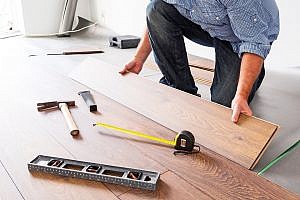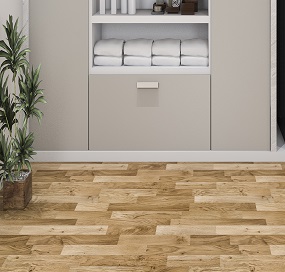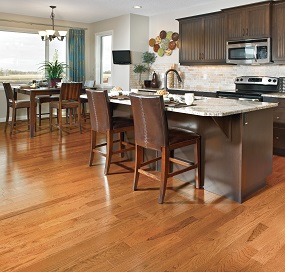How To Handle Water Damage On Wooden Floors
Introduction
As we all know, water may cause a damaging effect on your wooden floors. How to get the damaged flooring repaired, replaced, or refinished and make it look like as elegant as before is one of the major questions. In such situations, locating the source of water and then assessing the extent of damage to your floor is a smart move towards getting the right treatment for it. Water damage is most acute in wooden or hardwood flooring. Depending on the type of hardwood that has been used, the damage from water can vary in intensity as well as in results.
Let’s look at some of the most common manifestations of water damage:
-
Swelling of the Wood
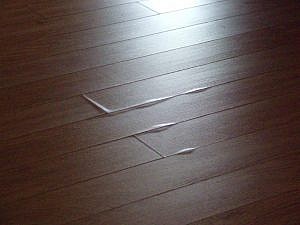
This is the most common outcome of water damage to wooden floors. Areas of the wood may become enlarged in size and the edges could get raised to a higher level than the middle. This would create a disconcerting convex shape that would be both aesthetically and practically hurtful.
-
Buckling of the Wooden Floor
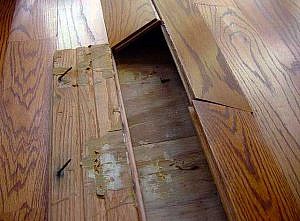
Buckling is the results of very serious water damage. Buckling causes part of the wooden flooring to move out of shape and get raised. This is the result of the adhesives that have been employed to attach wooden planks to the subfloor getting detached.
-
Discoloration
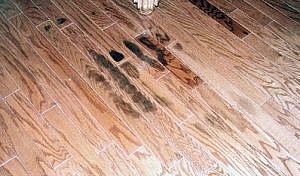
Discoloration of the floors is another common result of water damage. It is most likely to occur if floods in your area result in the whole floor getting immersed in the water. The results would be the growth of molds which would change the complexion of the wooden planks used in the flooring. Also, spots and specks may appear on your floor. As long as the moisture stays on the floor the problem would continue to grow.
- Water Accumulation
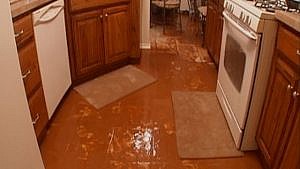
If you find areas in your house where water is getting accumulated or forming a little pool by itself, you need to act fast before the moisture causes irreparable damage. The causes of water accumulation are usually the malfunctioning of pipes nearby. The constant seepage of water into your wooden flooring will cause all the problems listed above.
-
Odor
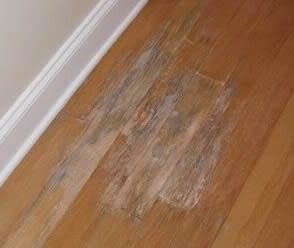
The odor is the result of the growth of molds on the flooring. This happens when there is a combination of moisture and low air passage. These two conditions combine to produce the perfect environment for the emergence of molds which won’t just produce ugly sports but would also give off an unpleasant odor.
Judging the Level of Damage
Once it is clear that your flooring has sustained damage from water, it becomes essential that you identify the amount of damage that has been caused to the floor. For this, you need to identify all the materials and adhesives that were employed in the construction of the floor as well as the amount of moisture the floor was soaked.
Here are some important steps that you need to take in order to understand the extent of the damage:
-
Remember the Type of Wood Used
The water damage your flooring would suffer depends greatly on the nature of the wood that has been employed. Some woods are more stubborn against water damage so they would be less altered. Usually, wooden floors and particularly hardwood floors are not water-resistant. But vinyl tiles and vinyl planks are water-resistant. Hence, find out which type of wood is used in the flooring of your house.
-
Find Out About the Adhesives Used as Well as the Material of Sub-flooring
Even if the wood used in flooring is able to withstand the damage of water, your flooring may still suffer disfigurement due to the effects on the adhesives used to bind the wooden flooring to the subfloor. On top of that, the water may seep into the sub-layer of the floor. How repellant or stubborn this layer is to water also needs to be found out in order for the damage to be properly understood.
-
Quantify the Level of Moisture
This is possibly the most important part of the assessment process. You need to find out the amount of water that has got locked into the wooden planks that are part of your floor. For this, there are various methods of testing that need to be employed.
There are dielectric meters that can scan your floor and find out the level of moisture in it. Then there is also insulated pin and hammer probes which are equally efficient at this task and can find out the level of moisture not just in the wooden flooring but also in the sub-flooring below.
Repairing of the Floor
If you have been unfortunate enough to have your floor badly damaged, then you have got no other option but to find out ways to repair it. The type of repair you employ depends upon various factors which have been stated above. The type of wood, the depth of the damage and the amount of moisture all affect the options you have.
Let’s explore the most common ways in which flooring can be repaired after damage:

-
Scraping of the Floor
This is the most basic and crude form of repair that can be utilized only if the damage to your floor is not at a very deep level. The optimum level to which a wood surface can be scraped off is 1/4th of an inch. This type of treatment is useful only if you are dealing with a problem of swelling or discoloration. This is also a good way of removing molds from the surface.
-
Dehumidification to Remove Moisture
Dehumidifiers are now available to remove moisture from your wooden flooring and prevent further damage. These machines should be placed on top of the wooden floors. Sometimes, having mats made from materials which assist in sucking of the water are also placed on the ground to make the job of dehumidifiers easier.
Apart from using dehumidifying machines, making your rooms better ventilated and allowing air to flow more easily through it will increase the pace of natural drying out process. If there is a room or basement below the floors, opening those areas and letting air and heat flow through easily and further assist the drying and dehumidification process.
-
Use of Sandpaper
Another way in which your wooden floor can be repaired after suffering severe water damage is by the use of sandpaper or even steel plates. If the damage is limited to the first two layers of finish, then using these devices to remove those layers is a great option.
-
Air Conditioners and Humidity Stabilizers
In order to remove moisture from the flooring, it is important to introduce dry hair that will suck it up. For this, using air-conditioners is a great option. It is also essential to reduce humidity so that the content of moisture doesn’t increase. If you have a humidity stabilizer, use it to maintain a low level of humidity.
When to Replace Your Flooring?
Sometimes, the damage to your floor is so bad that it can’t be repaired at all. In these situations, you are left with no choice but to change the flooring or that part of it which has been damaged. Such situations emerge in the following types of cases:
- If the amount of moisture in the wood has crossed a particular level, then the wood is damaged beyond repair and can’t be resurrected.
- If water has seeped through into the sub-floor, then also, the situation is hopeless and flooring has to be replaced.
- When the wooden planks in your flooring have buckled due to moisture, then they can’t be fitted back. You are again left with no option but to remove those damaged parts and put in new wooden boards. The main challenge is to find wooden boards that would fit into place exactly and would have the same color and texture, not to mention the grain.
Refinishing
Between repair and replacing, there is a third situation you may find – refinishing. If the damage to your floor is limited to the discoloration of the finish, then by sanding the floor to remove the top layer of finish and following it up by applying a new coat of finish is a great option.
Refinishing can be done either on the spot where the damage was or the planks have to be taken away outside. This depends upon the condition of the floorboards.
Conclusion

Water damage can completely destroy the beauty of your carefully curated flooring. However, you don’t need to worry too much. By taking help from professional agencies, the damage can be repaired or completely removed. With their assistance, your flooring would be back to its earlier condition.

